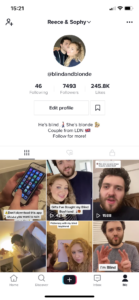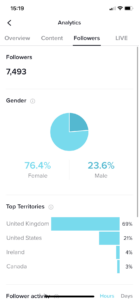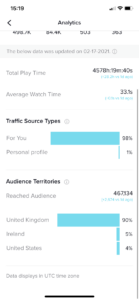What Loss in Sport Can Teach Us About Resilience & Mental Health
In the aftermath of the England men's football teams loss in the final of Euro 2020 last night, our client, and founder of mental health charity stem4, Dr. Nihara Krause shares the following advice:
Sport is one of the best ways for young people to learn about building resilience since it provides an opportunity to experience failure, and learn to deal with set-backs. Whilst it is important that sportspeople themselves learn to move away from being self-critical and harsh when they face a set-back, supporters can also play a role in building their resilience by avoiding placing unnecessary criticism and blame.
One major element of resilience and our ability to ‘bounce back’ is acceptance and compassion. In sport there is always going to be a ‘winner’ and a ‘loser’- and there is comfort in knowing that, high or low, this will always be a shared experience. In those times of loss, whilst sportspeople should learn to practice self-acceptance and self-compassion, supporters can also help by practicing ‘other-acceptance’ and kindness. In order to do this, both sportspeople and supporters need to learn to balance their thoughts and emotions.
Our emotions are very powerful. One emotion that is particularly hard to deal with is disappointment because it contains within it two very powerful emotions – sadness and hurt (which can often show as anger). Suppressing these emotions doesn’t work, so the first step is to find a way to express them in an effective and safe way. This might mean sharing feelings with friends, writing down how you feel, or doing something that’s self-soothing. Social media is not a good way to express emotion – it’s so immediate that it doesn’t provide the time for self-reflection, makes you lose control and spreads fast. So, talk with friends, or write things down the old-fashioned way with pen and paper for you to re-visit and re-read later. Expression helps reduce the strength of emotions and gives a ‘handle’ on being able to think differently.
The second step is to start exploring different perspectives. Is getting to the final goal the only achievement the team can make, or can you focus on all the other achievements that happen along the way? According to Winston Churchill, ‘success is the ability to go from one failure to another with no loss of enthusiasm.’
The third step is to catch the ‘negative thinker’ within you, and redirect your energy and focus onto all the positive solutions that are possible in the future. Disappointment can strengthen and lead to even greater strength and effectiveness. Let’s celebrate our English team and thank them for helping all of us learn that, although disappointment is inevitable, being discouraged and defeated is a choice.
Dr Nihara Krause, Stem4
Image Credit: Thomas Serer
How I went viral on TikTok
For those who are unaware of the social media platform of the moment, TikTok is a video-sharing app which saw a boom in users in 2020. The format is 15 to 60-second videos, with the front page having a ‘For You’ page in which an algorithm guesses what you would want to see and a ‘Following’ page which is only content from accounts that you follow. The primary users of TikTok are teens and young adults, but it is a place where anyone and anything can go viral overnight.

The boredom of lockdown inspired myself and my partner, Reece, to create a TikTok channel called @blindandblonde. For context, Reece is visually impaired, and we run the account together. We post both comedy and informative content about disability and living as an ‘interabled couple’, a term neither of us were aware of before TikTok.
A few weeks ago, I thought going viral on TikTok was something that could only be achieved once in a blue moon through sheer luck. There didn’t seem to be any rhyme or reason to why some of the videos we posted stalled below 200 views, and why some climbed a bit higher. The ‘For You’ page seemed so oversaturated with content already - how could we possibly get a video seen by more than a handful of people? Well, I’ve now discovered that there’s a lot more science behind it than I had first thought.
The first of our videos which amassed over 100,000 views in only a day was most certainly an accident. But since then, having achieved similar success with multiple other videos in the space of a couple of weeks, I have been able to pinpoint the things that can be actively done by a content creator to maximise the potential for going viral on TikTok. Here are some tips.
Authenticity and a USP
Another motivation for starting the page was seeing other visually impaired and blind creators in the space. But what really inspired our content, was the comments on said creators’ posts. They were infuriatingly stupid, with the likes of, “how do you know you are alive” being asked to one blind woman. Instead of going down the route of trying to educate people on blindness, we decided to flip it on its head and poke fun at the ridiculous questions and comments we saw on TikTok and that Reece is often posed with in everyday settings. We posted ‘Blind Morning Routine: Stereotype Edition’ as a response to this frustration, never expecting nearly 500,000 views, 125,000 likes and thousands of followers to come of it. The key to this success was the USP. Other creators were not successfully providing a comedic take on disability and many found the authenticity of the content to be refreshing.
@blindandblondeHow sighted people think I spend my mornings as a ##blind man 👨🏻🦯 ##spoof ##parody ##comedy ##fyp ##blindtok ##visuallyimpaired ##morningroutine ##vlog♬ Night & Day - Instrumental
Maximise Interactions
After reading through the comments on our first ‘viral’ post, we noticed the trend for users commenting about things that were not necessarily pointed out by us, but encouraged interaction, such as the toaster being plugged in next to Reece pouring water all over the counter when making tea (oops!). It is also the case that the more comments you have, the more the in-built algorithm will push your content out to peoples ‘For You’ pages. Therefore, we added subtle things to subsequent videos, such as saying “Alexa, play Stevie Wonder”, triggering viewers Alexa devices who found it so amusing we amassed hundreds of comments related to this. This certainly helped us to appear on the For You page and gain the same level of virality.
@blindandblondeHow sighted people think I spend my evenings as a ##blind man 💤👨🏻🦯🛌 ##spoof ##parody ##blindtok ##nightroutine ##comedy ##fyp ##visuallyimpaired♬ Night & Day - Instrumental
To maximise engagement on posts, we found that replying to comments and building up a relationship with viewers was key and very much encouraged people to hit the follow button. It has proved well to ask a question in the caption to invite comments. On our 'Gifts I’ve Bought My Blind Boyfriend' video, I wrote a caption which asked for people to give me more ideas – to which I received a number of comments with suggestions for accessible gifts.
@blindandblondeGive me some more gift ideas 🎁🥺🙏🏻 ##lockdownlove ##valentinesday ##blindtok ##blind ##couple ##giftideas ##fyp ##interabledcouple♬ Memories (In the Style of Maroon 5) [Karaoke Version] - Instrumental King
Analytics
A great feature of TikTok is that anyone can switch their account to a ‘Creator’ account in the settings. Doing this will allow you to see the analytics behind your account as a whole, as well as your individual videos. Here you can see the gender and location percentage of your followers, the average watch time on your videos, whether your video was seen mostly by followers or on the For You page and when your audience is most active.


Having this insight enabled us to pick the best time to post a video, according to when our followers were most likely to be scrolling, and to take into account our growing viewership from the USA. It is a great motivator for posting consistent and on-brand content that we know our audience will interact well with.
Overall, going accidentally viral has been an excellent introduction to the workings of TikTok. Unlike other platforms, you don’t necessarily need a fanbase already in place – it is more reliant on authentic and consistent content. When we started in January, we had 40 followers, and now we are approaching 8,000 just a month later. Whilst I’m certainly not being invited to Dubai to promote Sugar Bear Hair anytime soon, it’s been a fun experiment to distract from the monotony of lockdown.
See what our clients have to say about working with us.
How to make sure your Zoom call is really lit
Our friend Martin Kempton, an award-winning Lighting Director and Designer who worked on a range of high-profile shows at the BBC (everything from Eastenders to Top Of The Pops) recently took to Facebook to share his top tips about home lighting for Zoom calls. We could all do with a bit of help in this area, so with his kind permission, we're sharing them here:
Martin says, "A long time ago I used to do a bit of lighting for TV. I don’t know why it’s taken me so long to write this but – after nearly a year of looking at appallingly-lit people on Zoom – here are a few suggestions:
- Make sure the camera is as near eye level as possible. If you are looking down you will have a saggy neck and your eyes will be in shadow. Some TV presenters insist that their camera is above eye level – they know what makes them look good.
- Make sure the background is neither too bright nor too dark. Your computer exposes the camera to an average light level so your face will look far too bright if the background is very dark and vice versa.
- Following on from the above point – avoid seeing windows in the shot. Even on a dull day, any window will appear to be incredibly bright. Same with any lights – turn off or dim down to minimum any lights that the camera can see.
- Now the portraiture bit! Your key light should be slightly above eye level and slightly to one side of the camera. The most flattering form of light is soft – that means it produces a soft shadow, not a hard one. You can use a proper LED fixture (something like this one) or maybe a table light with a soft shade, (not a coloured shade obviously.) You could also bounce a desk light off a white wall or piece of card. If this sounds a bit too much then it’s to make you look good. No point in putting on nice makeup or combing your hair if your lighting makes you look old, tired and knackered.

- Avoid having light streaking down your face from an overhead fixture. I see this all the time. People switch on the central ceiling light and it illuminates their forehead and nose drawing attention to every tiny wrinkle and crease whilst leaving their eyes in deep shadow. It really is the most unflattering light possible! Also, make sure the sun doesn’t shine directly on you through a window for similar reasons.
- In the daytime, the best light is probably from a window behind the camera - or behind your webcam in your laptop lid. If this isn’t possible then artificial light as described above is best.
- If you can, plug your computer directly into your broadband hub using an ethernet cable, rather than relying on your home wi-fi connection. No matter how good or bad your internet wi-fi, it will make it far more reliable and will sharpen up your camera too!"
You can read more about Martin Kempton here
Next week we'll be sharing some more top tips about how to sound more professional on Zoom.
See what our clients have to say about working with us.
6 things to consider before creating your website
So you need a new website. Take it from us - you'll save yourself a lot of hassle by doing some simple research before diving into the deep end.
We get loads of people asking us where to start and what they should consider when building a website, which is great - we love working through the process from start to finish - but if you're looking to get the ball rolling quickly (or are just super-organised), we've compiled a list of what we think are the 6 essential factors you should consider.
This might sound obvious, but you need to have a clear objective for your website. Is it to create an online presence for your company? Is it for personal use, such as a blog or portfolio? Are you selling products? Is your website a place for customers/clients to contact you? Without a clear objective, it's almost impossible to get started.
Research your competitors' websites or find websites you like the look of. Not only will this help to narrow down your website's objective, but will give us an idea of what kind of style and design you want to achieve from your new website.
This is arguably the most important factor for a quick turnaround. You may already have a website and are happy with the content - that's fine, it's easy to transfer copy. If you have absolutely no content AT ALL, you need some. Whether you write it yourself or get someone to write it for you, the content helps to create a site map (a map of where everything goes on your website), which is the basis of any website. We have a brilliant copyrighter if you need some (or a lot!) of new content.
Without branding, your website has no identity. Even if your site is intended for personal use, there still needs to be an element of branding - "Joe Blogg's Portfolio" will suffice! For large companies, we're talking logos and any other branding material you may already have. Alternatively, we can design all kinds of branding material if you're looking to spruce up or modernise your current branding identity.
Your colour scheme may coincide with your branding, or maybe you have a clear vision of you’re your website will look like. Colours aren't necessarily the be-all and end-all, but it definitely helps to know the “feel” you're going for from the outset. We understand that picking colours to use on your website isn't as easy as it sounds (there are SO. MANY. COLOURS) but we're pretty well-tuned at picking colours that complement each other.
Last but definitely not least, images. Images images images. When was the last time you visited a (good) website without any images? We bet it's NEVER. Images of products, your local area, your team members, your premises, images of EVERYTHING relevant to your website/company are useful. The more personable, the better. We can use stock photos, but these aren't always a great idea, especially if you want your website to be totally individual and specific to your company (anyone can buy and use stock photos). It's also best to keep your images up-to-date, so if you're revamping an old website with old images, we'd recommend getting a professional in to take high-quality updated photos or even a state-of-the-art video. It'll be worth it, trust us!
Of course there are plenty of other factors you need to consider when building a website, but these 6 points are a great starting point. If you can nail the above nuts and bolts (excuse the pun) you're at a really great starting point. In fact, we'd say you're ready to take the plunge!
So what's stopping you? We'd love to hear from you. Just click here to get the ball rolling.
See what our clients have to say about working with us.
Email etiquette: Do you fall foul of these pet peeves?
269 billion emails were sent every day in 2017.
It’s no surprise that we’ve reached a point of ’email etiquette’ – unwritten rules about how emails should be written, read, and sent. The thing is, not everyone abides by these rules and it can get pretty frustrating.
So, what’s getting on our nerves about emails? We’ve listed our top offenders below.
DO “Reply to all”
Let’s say we are sending an email to person A and CC’ing person B and C. When person A replies, they don’t “reply to all”. Why?! Think about it: person B and C have been copied in for a reason, probably because they have some sort of involvement in the matter, yet when person A responds, they are ignoring those two people who probably need to know what’s going on.
The only occasion whereby you should omit the persons CC’d is if the conversation turns into something that does not involve them. Maybe they’re in Accounts and you’re now discussing design with person A – it’s perfectly acceptable to remove B and C from the conversation. Otherwise, PLEASE REPLY ALL.
NB: We should also state it’s imperative you only CC people necessary – no one wants to receive unwanted emails, ever.
No email signature
If we had a pound for every time we’ve tried to find someone’s contact details in their email signature, only to find they don’t have one, we’d be rich. Or at least £100 better off. You should make it as easy as possible for your customers or clients to be able to contact you. Adding your phone number and website address to your email signature not only achieves this but drives traffic to your website. Better yet, it’s completely free to do. It’s a no-brainer!
Clear subject lines
Remember when we said 269 billion emails are sent every day?* Think about how many emails you receive daily. Now think again – how many of these emails have a clear, concise subject line? We can’t stress enough how important a good subject line is, and quite frankly, we’re much more likely attend to an email with a clear subject line as opposed to a confusing one – or worse – NO subject line. If you deal with multiple clients/locations/stores/teams, try to structure your subject line like this: who – what – action. For example, “Wimbledon Tennis – Social media strategy – Decision needed”. Easy.
Beware of the dreaded typo.

Businesses that use anonymous email addresses
Have you ever received a generic response from a company signed off with “Sales Team” or something similar? We understand why small businesses might use this tactic – to appear larger – but wouldn’t you much rather know who you’re talking to? Even just a first name will suffice. It makes your correspondence much more personal and tells your customer/client who to contact in the future if required.
Proof-reading
Before you click “send”, take a quick glance at your email. You’ll be surprised how many emails we receive with typos and whole sentences missing. This can be extremely frustrating, especially when these are instructions that need to be followed. We use Grammarly to flag our typos and grammatical errors.
What annoys you about emails? We’d love to know. Comment below and who knows, we might even add it to our list…
Up your game with these 9 Instagram hacks
It's tough in the world of Instagram.
With over 500 million active monthly users, it can be difficult to find and interact with your ideal audience. Are you struggling to create content that people like, or failing to gain engagement and followers? Get the most out of Instagram with these nine hacks.
1. Hashtags
Did you know the most popular Instagram hashtag is #love? A sure-fire way of getting more likes, followers and comments is by using hashtags. Use appropriate (repeat: appropriate) hashtags on your posts and you’ll find your engagement rates sky rocket. You’re allowed to use up to 30 tags per post, excluding comments, which means you can comment on your own photos with extra hashtags to reach more people. Do some research about what your competitors are tagging and, if you can think of a use for it, create your own hashtag.
2. Lighting
Instagram is all about photos, and good photos need great lighting. A well-lit, naturally bright photo will always get more likes than a dark photo. It’s a no-brainer. Try to take your photos in a light room (or outdoors), but stay away from harsh sunlight.
3. Angle
Know your flat lays to your FWIS’s. Products, food, clothes and more can benefit from flat lays. Essentially this is taking a birds-eye view photo of your subject laid flat on a surface. Check out @flatlays Instagram account for inspiration. FWIS (From Where I Stand) is another popular Instagram angle, which creates a sense of viewing life through someone else’s eyes. Just make sure you have cool shoes on. Check out @fromwhereistand.
4. Filter
Instagram’s own filters are sufficient for some, but not us. We love Ludwig, Juno and Crema, but sometimes it’s just not enough. Use your phone’s inbuilt photo editing software or our favourite app, VSCO, for more editing options. VSCO has hundreds of free filters to choose from and, better yet, you can upload a VSCO edited image to Instagram and continue to edit in-app. Your editing options are endless, just don’t go OTT. Once you’ve found your favourite filter style, try to stick to it.
Know your flat lays to your FWIS’s.
5. Captions
Keep them short, sweet, informative. Think of it this way: if you’re posting a photo of your dinner, we already know quite a lot about your meal. You might want to tell us what it is, if it was nice, or how to make it. Instagram users scroll through photos quickly, so you don’t have much time to grab their attention. Chuck in an emoji if you’re feeling fancy.
6. Timing
When’s the best time to post on Instagram? Good question. Start with your audience demographic. How old are they? If they’re of working age, posting during working hours should be avoided. Where do they live? Don’t forget about time differences. If your audience is in the UK and USA, posting in the evening (UK time) is a good place to start. When is your audience online? At school, whilst commuting, whilst the kids are at school, in the evening, etc. Think about your audience, combine these answers and you’ll find your perfect time to post on Instagram.
7. Links
Instagram does not like links. No one will copy a link and paste it into their phone’s browser, so don’t bother pasting a link into the caption of your photo. The only way around this is by changing the clickable link in your Instagram bio. If you’re releasing a new product, plugging a blog post, or referring to a recipe, pop the link in the URL section of your bio. Change this link before you post or immediately afterwards – IGers are fast movers.
8. Take advantage of Instagram’s apps
Instagram is not a one-app band. In fact there are three official sub-Instagram apps to enhance your Instagram experience. Boomerang adds fun to your stream by creating short, snappy videos that play on a loop (a bit like Vine, but shorter). Layout answers all your photo mosaic prayers, giving users a number of – you guessed it – layouts to input multiple photos. Hyperlapse creates stabilised time lapse videos that allows you to edit the speed of the video.
9. Engagement
Believe it or not, Instagram isn’t just about cool photos. There are real people behind Instagram accounts, and they like to talk. If someone comments on your post, don’t ignore it. Respond to get the conversation flowing. In the same breath, spend time commenting on other people’s posts, too. You’ll find that this helps to get you noticed as an active and engaging user, which is exactly the kind of user people want to follow. Ka-ching.
That’s it. Whilst nothing happens overnight, if you abide by these nine hacks, you’ll no doubt propel yourself (or your company) through the harsh digital world that is Instagram. Good luck!






